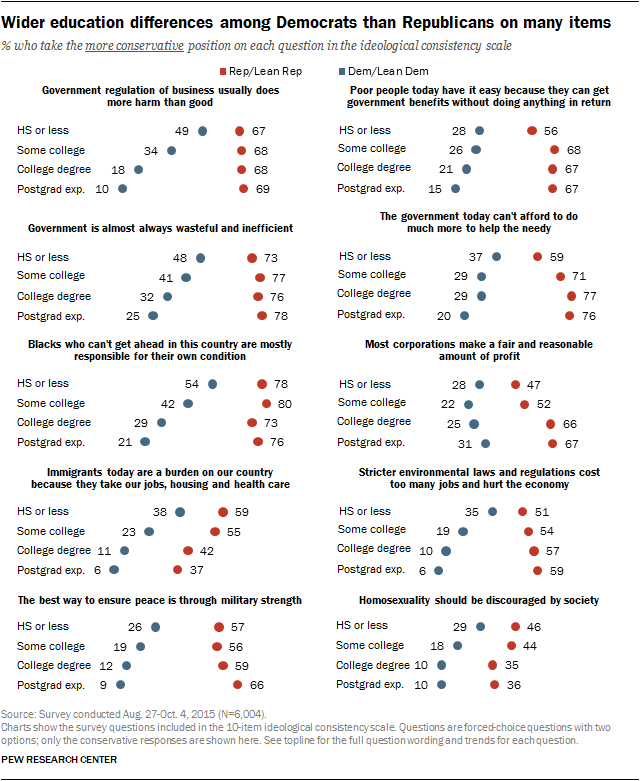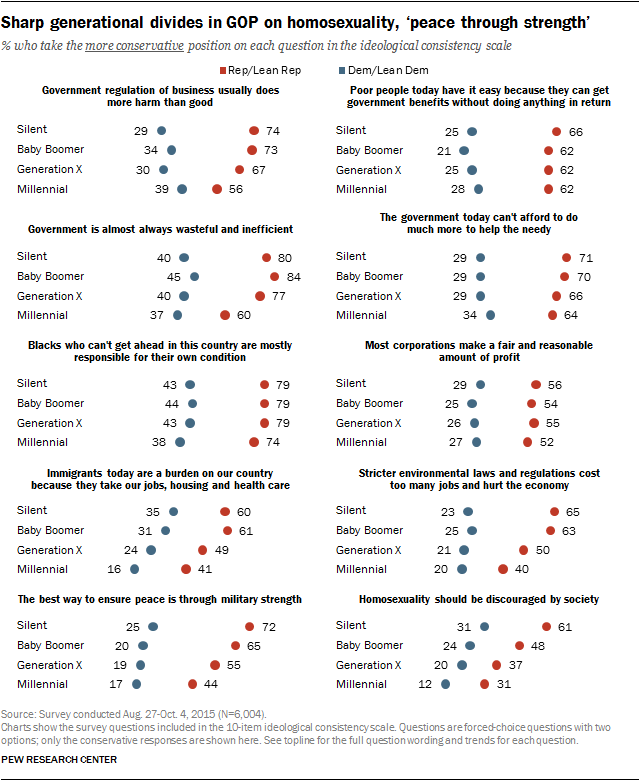Survey Report
Two years ago, Pew Research Center found that Republicans and Democrats were more divided along ideological lines than at any point in the previous two decades. But growing ideological distance is not confined to partisanship. There are also growing ideological divisions along educational and generational lines.
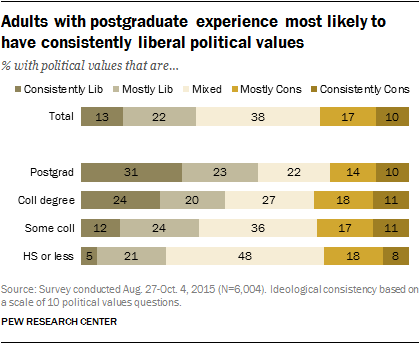
Highly educated adults – particularly those who have attended graduate school – are far more likely than those with less education to take predominantly liberal positions across a range of political values. And these differences have increased over the past two decades.
More than half of those with postgraduate experience (54%) have either consistently liberal political values (31%) or mostly liberal values (23%), based on an analysis of their opinions about the role and performance of government, social issues, the environment and other topics. Fewer than half as many postgrads – roughly 12% of the public in 2015– have either consistently conservative (10%) or mostly conservative (14%) values. About one-in-five (22%) express a mix of liberal and conservative opinions.
Among adults who have completed college but have not attended graduate school (approximately 16% of the public), 44% have consistently or mostly liberal political values, while 29% have at least mostly conservative values; 27% have mixed ideological views.
By contrast, among the majority of adults who do not have a college degree (72% of the public in 2015), far fewer express liberal opinions. About a third of those who have some college experience but do not have a bachelor’s degree (36%) have consistently liberal or mostly liberal political values, as do just 26% of those with no more than a high school degree. Roughly a quarter in each of these groups (28% of those with some college experience, 26% of those with no more than a high school education) have consistently conservative or mostly conservative values.
Taking a roughly equal mix of liberal and conservative positions is far more prevalent among those with less education than those with at least a college degree. For instance, nearly half (48%) of those with a high school degree or less education express a mix of conservative and liberal opinions. That compares with just 22% of those with postgraduate experience.
Over the past decade, ideological differences across generations also have widened. Millennials remain more liberal than older generations – 45% express consistently liberal or mostly liberal views, which is little changed from 2004 (41%). In contrast, growing shares of the oldest cohorts – Boomers and Silents – have conservative political values. About a third of Boomers (36%) and 40% of Silents have at least mostly conservative attitudes, up from 21% and 23%, respectively, in 2004.
This analysis is based on a survey conducted last fall among more than 6,000 adults, and draws from data on Pew Research Center surveys going back to 1994. Responses to 10 political values questions – covering opinions about government performance, the social safety net, the environment, immigration, homosexuality and other topics – asked together in each of these surveys were combined to create a scale of ideological consistency.
More highly educated adults have consistently liberal views
As Pew Research Center’s 2014 report on political polarization found, the share of the overall public that is ideologically consistent – that is, the share that takes either consistently liberal or consistently conservative positions opinions across the 10 values – is relatively modest, but has grown substantially over time, especially over the past decade.
In the new study, nearly a quarter of Americans (23%) have either consistently liberal (13%) or consistently conservative views (10%). In 2004, just 11% were either consistently liberal (8%) or consistently conservative (3%).
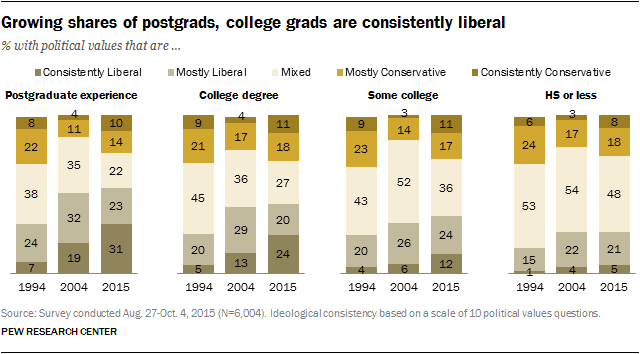
Much of the growth in ideological consistency has come among better educated adults – including a striking rise in the share who have across-the-board liberal views, which is consistent with the growing share of postgraduates who identify with or lean toward the Democratic Party .
Currently, about a third of those with postgraduate experience (31%) give down-the-line liberal responses across the 10 items, up from 19% in 2004 and just 7% in 1994. Among college graduates with no postgraduate experience, 24% have consistently liberal values, compared with 13% in 2004 and 5% a decade earlier.
Among postgrads and college graduates, the shares expressing consistently conservative views also have grown since 2004, from 4% to 10% among postgrads and from 4% to 11% among college graduates. But among both groups, consistently conservative views are at the about the same levels as they had been in 1994.
In contrast with Americans with a college degree, among those with less education smaller shares express ideologically consistent views and those who do are about as likely to be consistently conservative (11% of those with some college experience, 8% of those with no more than a high school education) as they are to be consistently liberal (12% of some college, 5% of high school or less). Larger shares take a mix of liberal and conservative positions: Roughly half of those with no more than a high school education (48%) are ideologically mixed, along with 36% of those with some college experience. By contrast, only about a quarter of more educated Americans have ideologically mixed views.
Across all educational categories – and among the public generally – the shares of Americans who take a roughly equal number of liberal and conservative positions have declined over the past two decades. But the declines have been more pronounced among postgraduates (from 38% to 22%) and college graduates (45% to 27%), than among those with some college experience (from 43% to 36%) or those with a high school degree or less education (from 53% to 48%).
Republicans and Democrats, moving apart
Overall, 38% of the public expresses a mix of liberal and conservative positions. In both 1994 and 2004, nearly half (49%) had mixed attitudes. As our 2014 polarization study found, Republicans and Democrats increasingly are on opposite sides of the ideological spectrum.
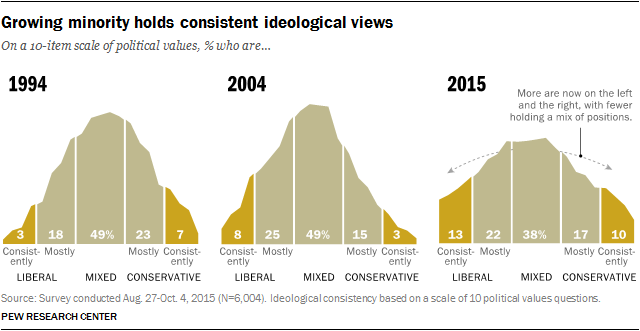
Currently, 60% of Democrats and Democratic leaners have consistently liberal or mostly liberal political values, double the share in 1994 (30%) and 11 percentage points higher than in 2004. And the share of Democrats with consistently liberal views has increased from just 5% in 1994 to 13% in 2004 and 27% currently.
The share of Republicans and Republican leaners with at least mostly conservative values fell from 45% in 1994 to 31% in 2004, but has rebounded since then. In the new study, slightly more than half of Republicans (53%) express consistently or mostly conservative attitudes. The share with consistently conservative political values has increased from just 6% in 2004 to 22% currently.
Democrats and Republicans more ideologically divided
Today, an overwhelming share of Republicans (93%) is more conservative than the median Democrat, while a nearly identical share of Democrats (94%) is more liberal than the median Republican. Two decades ago, a much smaller majority of Republicans (64%) were to the right of the median Democrat, while 70% of Democrats were to the left of the median Republican.
[ps_interactive siteid=”4″ id=”20059833″ showtitle=”false”]
Most Democratic postgrads are consistently liberal
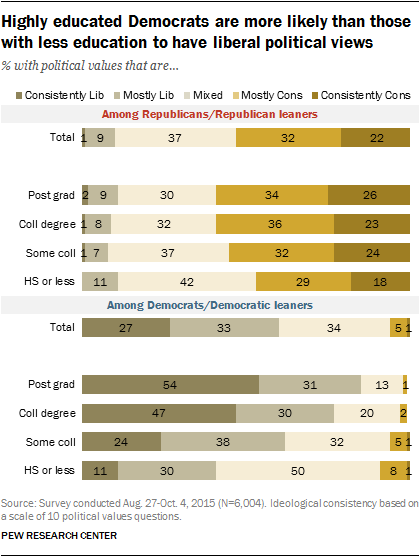
Over the past two decades, the increase in consistently liberal views has been most pronounced among highly-educated Democrats and Democratic leaners.
Among Democrats with postgraduate experience, 54% express consistently liberal views, compared with 34% who did so in 2004 and just 16% a decade before that. Among Democratic college graduates with no postgraduate experience, the proportion that is consistently liberal has nearly quadrupled since 1994, from 12% to 47%.
By contrast, far smaller shares of Democrats with some college experience (24%) and no more than a high school education (11%) are consistently liberal, and there has been less change over the past two decades.
The change in attitudes among Republicans and Republican leaners has followed a very different trajectory over the past two decades. As noted in the 2014 Polarization report, the overall share of Republicans with predominantly conservative political values declined between 1994 and 2004, before rebounding in recent years. This pattern is seen across all educational categories.
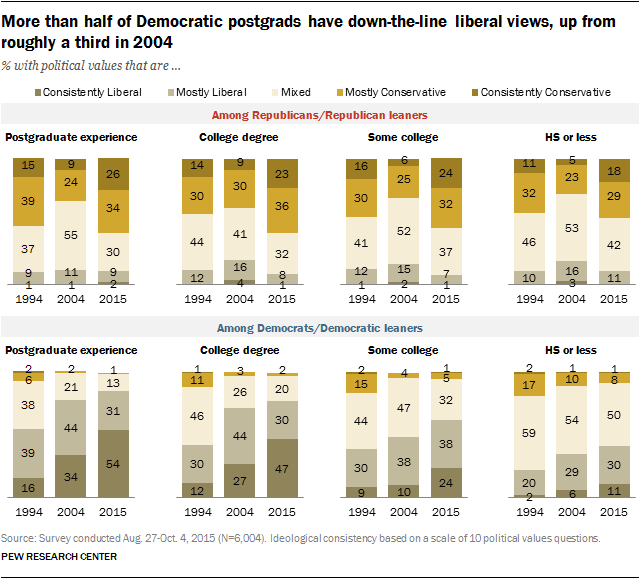
Moreover, the gap in ideological consistency among Republicans with different levels of educational attainment is much smaller than among Democrats. In the new study, comparable shares of Republican postgrads (26%), college graduates (23%), and those with some college experience but no diploma (24%) express consistently conservative values, as do 18% of Republicans with a high school degree or less education. In contrast, there is a 43-precentage-point gap in the shares of Democratic postgrads (54%) and Democrats with no more than a high school education (11%) that express consistently liberal attitudes.
Generations and ideological consistency
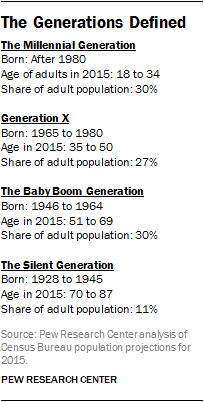
There are wide generational differences in political values, based on the 10-item scale. Millennials continue to be considerably more liberal than older generations. (For more on ideological differences across generations, see “The GOP’s Millennial Problem Runs Deep.”)
Among Millennials, 45% express consistently liberal (16%) or mostly liberal views (29%), compared with just 15% who have conservative attitudes. Four-in-ten Millennials have a mix of conservative and liberal views.
Across older generations, fewer have liberal political values. About a third of Gen Xers (36%) have at least mostly liberal attitudes, while 23% have mostly conservative attitudes; 41% are mixed ideologically. Among Boomers, more have conservative (36%) than liberal (30%) attitudes; 34% have mixed views. And among Silents, 40% are conservative – including 21% who are consistently conservative – while 26% are liberal and 34% express a mix of conservative and liberal views.
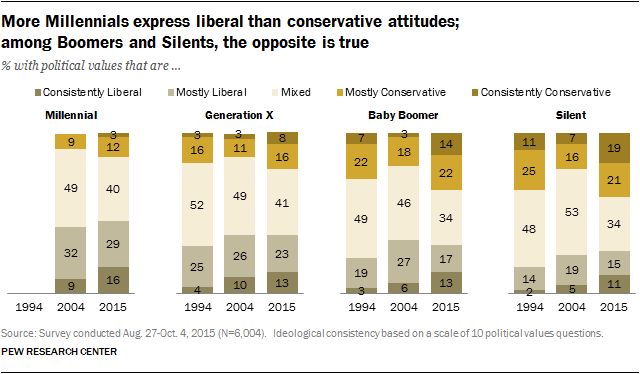
Notably, while there are wider ideological differences among Democrats than Republicans by levels of educational attainment, Republicans are more deeply divided along generational lines.
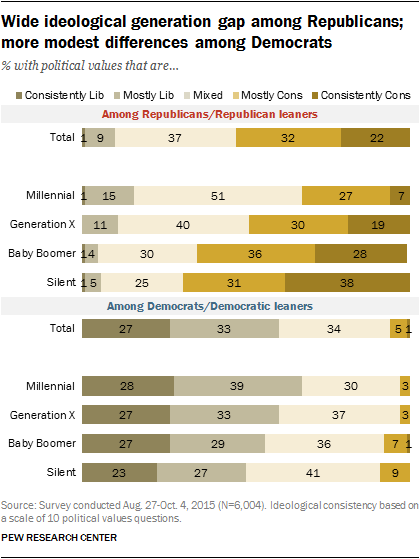
Sizable majorities of older Republicans – 64% of Boomers and 69% of Silents – have at least mostly conservative attitudes across the 10-item scale. More than a quarter of Republican Boomers (28%) and 38% of Republican Silents give down-the-line conservative responses. Both groups have become substantially more conservative over the past decade.
By contrast, only about half of Gen X Republicans (49%) express consistently or mostly conservative views – although that share has roughly doubled, from 24%, since 2004. Only about a third of Millennial Republicans (34%) express at least mostly conservative views, just half the share among Silent Republicans.
There are smaller generational differences among Democrats, although Millennial Democrats (66%) are somewhat more likely than those in older generations to have liberal political values. Nearly identical shares across each cohort of Democrats – 28% of Millennials, 27% of Gen Xers and Boomers, and 23% of Silents – express consistently liberal views. Among the three older cohorts of Democrats, the numbers with consistently liberal attitudes has increased substantially over the past two decades.
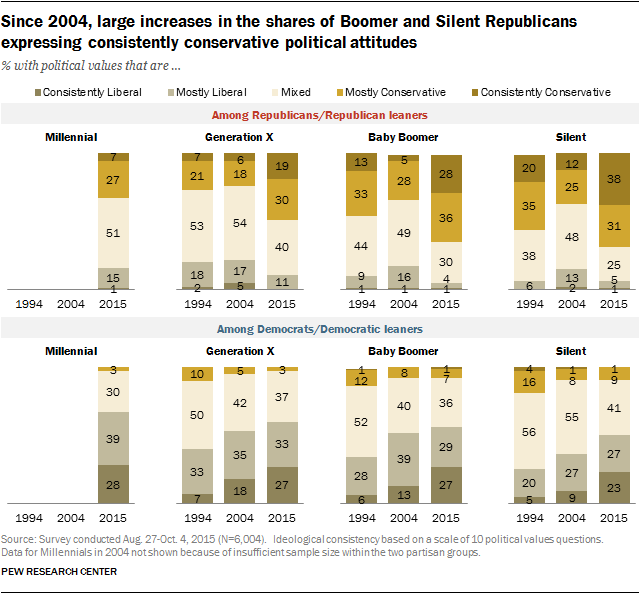
Partisan divides have widened on many political values
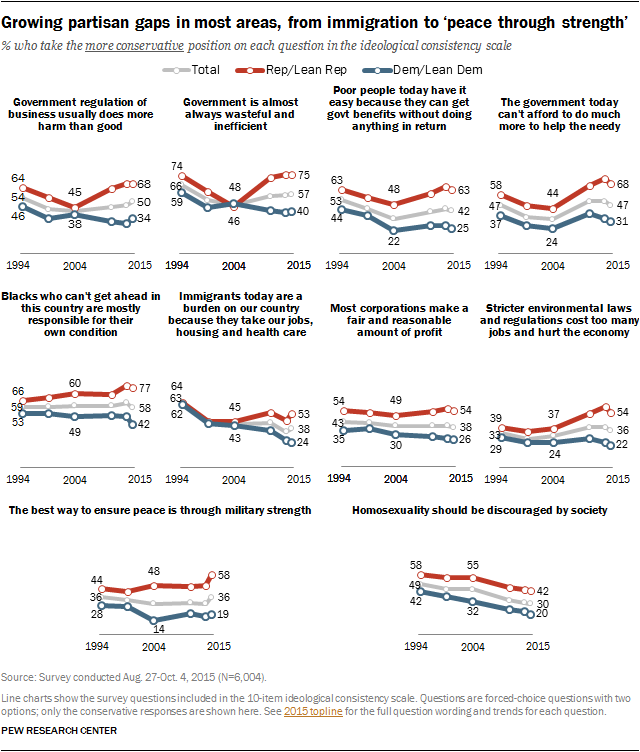
As noted in the 2014 report, partisan divisions have increased over the past two decades on most of the measures that make up the 10-item ideological consistency scale. In some cases, such as in opinions about the economic effect of stricter environmental laws, the differences were fairly modest 20 years ago; at that time, 39% of Republicans and 29% of Democrats said stricter environmental laws cost too many jobs and hurt the economy. In 2015, more than half of Republicans (54%) and just 22% of Democrats expressed this view.
On immigration and homosexuality, overall attitudes have shifted in a more liberal direction over the past 20 years. Still, partisan differences on both issues remain substantial and, in the case of immigration, have increased dramatically since the mid-1990s. In 1994, 64% of Republicans and 62% of Democrats said immigrants were a burden on the country because they took jobs and health care. In fall 2015, 53% of Republicans said immigrants were a burden on the country, compared with just 24% of Democrats. (The partisan gap has widened even more since then: in a survey last month, 56% of Republicans viewed immigrants as a burden on the country; just 17% of Democrats said the same.)
On two measures related to government performance, partisan differences narrowed considerably between 1994 and 2004, before resurfacing in recent years. The share of Republicans saying government regulation of business did more harm than good fell from 64% in 1994, during the Clinton administration, to 45% in 2004, during George W. Bush’s presidency. In the fall of 2015, 68% of Republicans said government of regulation of business did more harm than good.
Democrats’ views on government regulation of business have shown far less change over this period: in 1994, 46% said government regulation did more harm than good. That fell to 38% in 2004 and 34% in 2015. A similar pattern is evident in changes in partisan views of whether government is wasteful and inefficient.
Partisan differences over issues, by education and generation
As noted, Democrats with differing levels of education are more ideologically divided than Republicans, with some of the widest gaps on opinions about government regulation of business and race. Republicans are more divided along generational lines, especially in attitudes on homosexuality and immigration.
